41 6.6 Friction
Summary
- Discuss the general characteristics of friction.
- Describe the various types of friction.
- Calculate the magnitude of static and kinetic friction.
Friction is a force that is around us all the time that opposes relative motion between systems in contact but also allows us to move (which you have discovered if you have ever tried to walk on ice). While a common force, the behaviour of friction is actually very complicated and is still not completely understood. We have to rely heavily on observations for whatever understandings we can gain. However, we can still deal with its more elementary general characteristics and understand the circumstances in which it behaves.
FRICTION
Friction is a force that opposes relative motion between systems in contact.
One of the simpler characteristics of friction is that it is parallel to the contact surface between systems and always in a direction that opposes motion or attempted motion of the systems relative to each other. If two systems are in contact and moving relative to one another, then the friction between them is called kinetic friction. For example, friction slows a hockey puck sliding on ice. But when objects are stationary, static friction can act between them; the static friction is usually greater than the kinetic friction between the objects.
KINETIC FRICTION
If two systems are in contact and moving relative to one another, then the friction between them is called kinetic friction.
Imagine, for example, trying to slide a heavy crate across a concrete floor—you may push harder and harder on the crate and not move it at all. This means that the static friction responds to what you do—it increases to be equal to and in the opposite direction of your push. But if you finally push hard enough, the crate seems to slip suddenly and starts to move. Once in motion it is easier to keep it in motion than it was to get it started, indicating that the kinetic friction force is less than the static friction force. If you add mass to the crate, say by placing a box on top of it, you need to push even harder to get it started and also to keep it moving. Furthermore, if you oiled the concrete you would find it to be easier to get the crate started and keep it going (as you might expect).
Figure 1 is a crude pictorial representation of how friction occurs at the interface between two objects. Close-up inspection of these surfaces shows them to be rough. So when you push to get an object moving (in this case, a crate), you must raise the object until it can skip along with just the tips of the surface hitting, break off the points, or do both. A considerable force can be resisted by friction with no apparent motion. The harder the surfaces are pushed together (such as if another box is placed on the crate), the more force is needed to move them. Part of the friction is due to adhesive forces between the surface molecules of the two objects, which explain the dependence of friction on the nature of the substances. Adhesion varies with substances in contact and is a complicated aspect of surface physics. Once an object is moving, there are fewer points of contact (fewer molecules adhering), so less force is required to keep the object moving. At small but nonzero speeds, friction is nearly independent of speed.
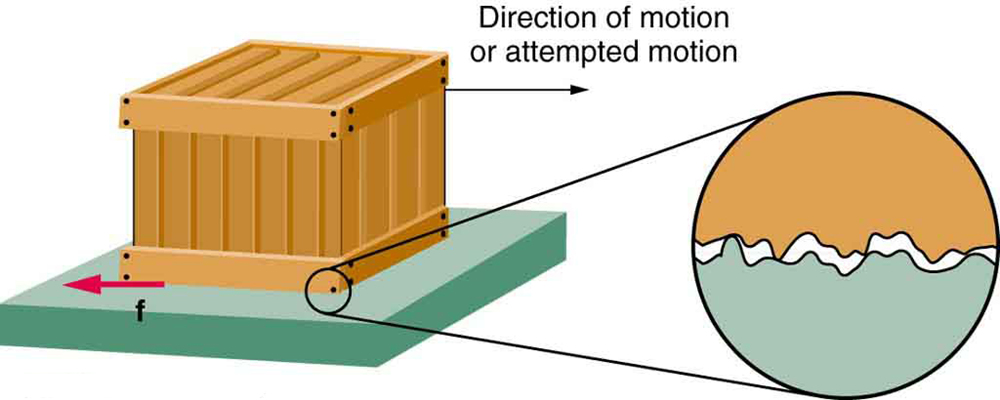
The magnitude of the frictional force has two forms: one for static situations (static friction), the other for when there is motion (kinetic friction).
When there is no motion between the objects, the magnitude of static friction fs is
where μs is the coefficient of static friction and N is the magnitude of the normal force (the force perpendicular to the surface).
MAGNITUDE OF STATIC FRICTION
Magnitude of static friction fs is
where μs is the coefficient of static friction and N is the magnitude of the normal force.
The symbol ≤ means less than or equal to, implying that static friction can have a minimum and a maximum value of μsN. Static friction is a responsive force that increases to be equal and opposite to whatever force is exerted, up to its maximum limit. Once the applied force exceeds fs(max), the object will move. Thus
Once an object is moving, the magnitude of kinetic friction fk is given by
where μk is the coefficient of kinetic friction. A system in which fk = μkN is described as a system in which friction behaves simply.
MAGNITUDE OF KINETIC FRICTION
The magnitude of kinetic friction fk is given by
where μk is the coefficient of kinetic friction.
As seen in Table 1, the coefficients of kinetic friction are less than their static counterparts. That values of μ in Table 1 are stated to only one or, at most, two digits is an indication of the approximate description of friction given by the above two equations.
| [latex]\textbf{System}[/latex] | [latex]\textbf{Static friction,}\boldsymbol{\mu_{\textbf{s}}}[/latex] | [latex]\textbf{Kinetic friction,}\boldsymbol{\mu_{\textbf{k}}}[/latex] |
|---|---|---|
| Rubber on dry concrete | 1.0 | 0.7 |
| Rubber on wet concrete | 0.7 | 0.5 |
| Wood on wood | 0.5 | 0.3 |
| Waxed wood on wet snow | 0.14 | 0.1 |
| Metal on wood | 0.5 | 0.3 |
| Steel on steel (dry) | 0.6 | 0.3 |
| Steel on steel (oiled) | 0.05 | 0.03 |
| Teflon on steel | 0.04 | 0.04 |
| Bone lubricated by synovial fluid | 0.016 | 0.015 |
| Shoes on wood | 0.9 | 0.7 |
| Shoes on ice | 0.1 | 0.05 |
| Ice on ice | 0.1 | 0.03 |
| Steel on ice | 0.4 | 0.02 |
| Table 1. Coefficients of Static and Kinetic Friction. | ||
The equations given earlier include the dependence of friction on materials and the normal force. The direction of friction is always opposite that of motion, parallel to the surface between objects, and perpendicular to the normal force. For example, if the crate you try to push (with a force parallel to the floor) has a mass of 100 kg, then the normal force would be equal to its weight, W = mg = (100 kg)(9.80 m/s2) = 980 N, perpendicular to the floor. If the coefficient of static friction is 0.45, you would have to exert a force parallel to the floor greater than fs(max) = μN = (0.45)(980 N) = 440 N to move the crate. Once there is motion, friction is less and the coefficient of kinetic friction might be 0.30, so that a force of only 290 N (fk = μkN = (0.30)(980 N) = 290 N) would keep it moving at a constant speed. If the floor is lubricated, both coefficients are considerably less than they would be without lubrication. Coefficient of friction is a unit less quantity with a magnitude usually between 0 and 1.0. The coefficient of the friction depends on the two surfaces that are in contact.
Many people have experienced the slipperiness of walking on ice. However, many parts of the body, especially the joints, have much smaller coefficients of friction—often three or four times less than ice. A joint is formed by the ends of two bones, which are connected by thick tissues. The knee joint is formed by the lower leg bone (the tibia) and the thighbone (the femur). The hip is a ball (at the end of the femur) and socket (part of the pelvis) joint. The ends of the bones in the joint are covered by cartilage, which provides a smooth, almost glassy surface. The joints also produce a fluid (synovial fluid) that reduces friction and wear. A damaged or arthritic joint can be replaced by an artificial joint (Figure 2). These replacements can be made of metals (stainless steel or titanium) or plastic (polyethylene), also with very small coefficients of friction.
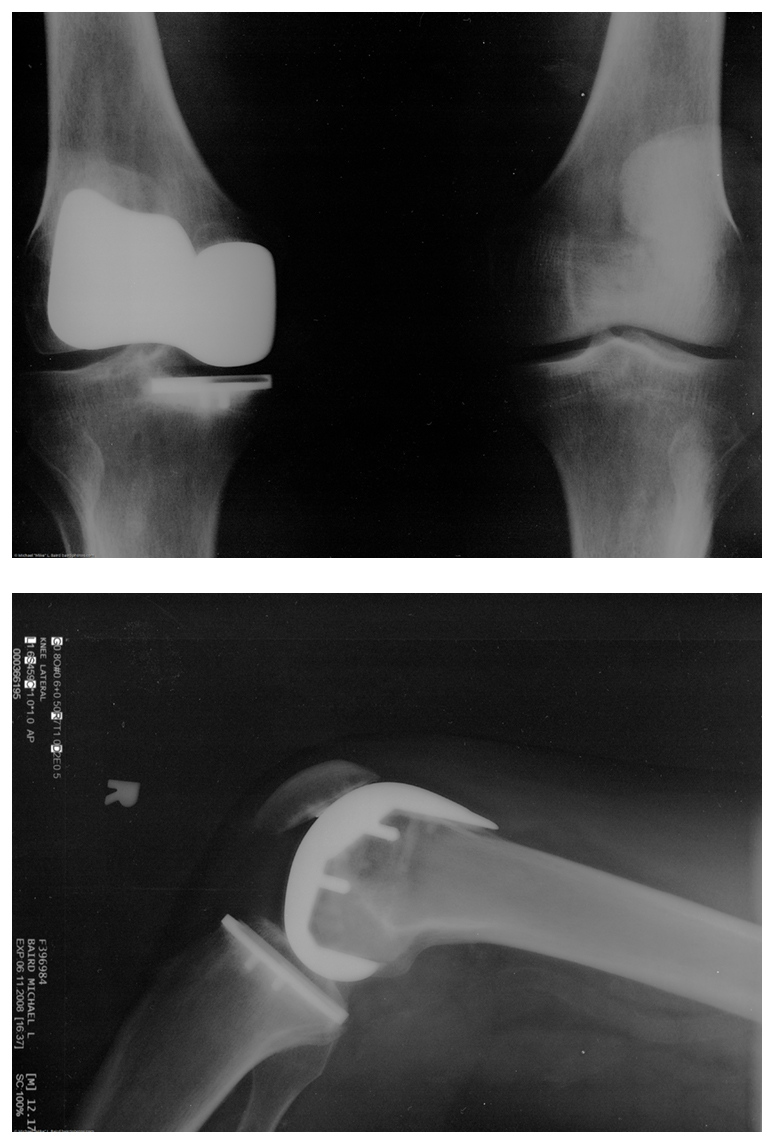
Other natural lubricants include saliva produced in our mouths to aid in the swallowing process, and the slippery mucus found between organs in the body, allowing them to move freely past each other during heartbeats, during breathing, and when a person moves. Artificial lubricants are also common in hospitals and doctor’s clinics. For example, when ultrasonic imaging is carried out, the gel that couples the transducer to the skin also serves to to lubricate the surface between the transducer and the skin—thereby reducing the coefficient of friction between the two surfaces. This allows the transducer to mover freely over the skin.
Example 1: Skiing Exercise
A skier with a mass of 62 kg is sliding down a snowy slope. Find the coefficient of kinetic friction for the skier if friction is known to be 45.0 N.
Strategy
The magnitude of kinetic friction was given in to be 45.0 N. Kinetic friction is related to the normal force N as fk = μkN; thus, the coefficient of kinetic friction can be found if we can find the normal force of the skier on a slope. The normal force is always perpendicular to the surface, and since there is no motion perpendicular to the surface, the normal force should equal the component of the skier’s weight perpendicular to the slope. (See the skier and free-body diagram in Figure 3.)
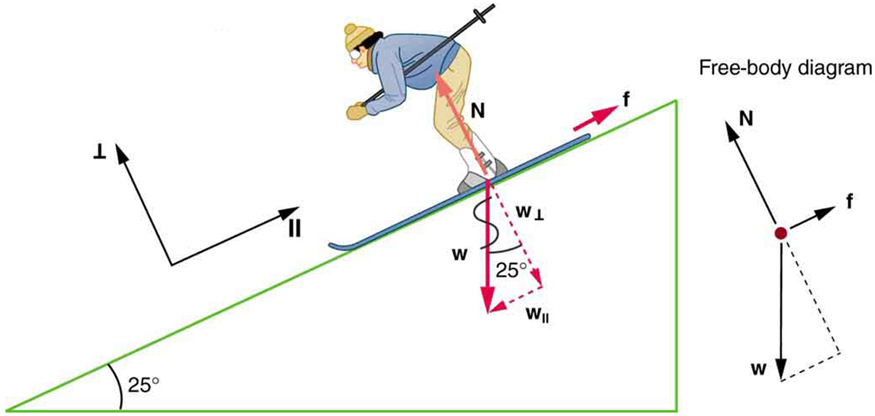
That is,
Substituting this into our expression for kinetic friction, we get
which can now be solved for the coefficient of kinetic friction μk.
Solution
Solving for μk gives
Substituting known values on the right-hand side of the equation,
Discussion
This result is a little smaller than the coefficient listed in Table 1 for waxed wood on snow, but it is still reasonable since values of the coefficients of friction can vary greatly. In situations like this, where an object of mass m slides down a slope that makes an angle θ with the horizontal, friction is given by fk = μkmg cos θ. All objects will slide down a slope with constant acceleration under these circumstances. Proof of this is left for this chapter’s Problems and Exercises.
We have discussed that when an object rests on a horizontal surface, there is a normal force supporting it equal in magnitude to its weight. Furthermore, simple friction is always proportional to the normal force.
PHET EXPLORATIONS: FORCES AND MOTION
Explore the forces at work when you try to push a filing cabinet. Create an applied force and see the resulting friction force and total force acting on the cabinet. Charts show the forces, position, velocity, and acceleration vs. time. Draw a free-body diagram of all the forces (including gravitational and normal forces).
 Figure 6. Forces and Motion
Figure 6. Forces and MotionSection Summary
- Friction is a contact force between systems that opposes the motion or attempted motion between them. Simple friction is proportional to the normal force N pushing the systems together. (A normal force is always perpendicular to the contact surface between systems.) Friction depends on both of the materials involved. The magnitude of static friction fs between systems stationary relative to one another is given by
[latex]\boldsymbol{f_{\textbf{s}}\leq\mu\textbf{N},}[/latex]
where μs is the coefficient of static friction, which depends on both of the materials.
- The kinetic friction force fk between systems moving relative to one another is given by
[latex]\boldsymbol{f_{\textbf{k}}=\mu_{\textbf{k}}\textbf{N},}[/latex]
where μkis the coefficient of kinetic friction, which also depends on both materials.
Conceptual Questions
1: Define normal force. What is its relationship to friction when friction behaves simply?
Problems & Exercises
1: (a) What is the maximum frictional force in the knee joint of a person who supports 66.0 kg of her mass on that knee? (b) During strenuous exercise it is possible to exert forces to the joints that are easily ten times greater than the weight being supported. What is the maximum force of friction under such conditions? The frictional forces in joints are relatively small in all circumstances except when the joints deteriorate, such as from injury or arthritis. Increased frictional forces can cause further damage and pain.
2: A team of eight dogs pulls a sled with waxed wood runners on wet snow (mush!). The dogs have average masses of 19.0 kg, and the loaded sled with its rider has a mass of 210 kg. (a) Calculate the magnitude of the acceleration starting from rest if each dog exerts an average force of 185 N backward on the snow. (b) What is the magnitude of the acceleration once the sled starts to move? (c) For both situations, calculate the magnitude of the force in the coupling between the dogs and the sled.
3: Consider the 65.0-kg ice skater being pushed by two others shown in Figure 7. (a) Find the direction and magnitude of Ftot, the total force exerted on her by the others, given that the magnitudes F1 and F2 are 26.4 N and 18.6 N, respectively. (b) What is her initial acceleration if she is initially stationary and wearing steel-bladed skates that point in the direction of Ftot? (c) What is her acceleration assuming she is already moving in the direction of Ftot? (Remember that friction always acts in the direction opposite that of motion or attempted motion between surfaces in contact.)
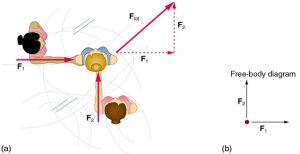
4: Show that the acceleration of any object down a frictionless incline that makes an angle θ with the horizontal is a = g sin θ. (Note that this acceleration is independent of mass.)
5: Show that the acceleration of any object down an incline where friction behaves simply (that is, where fk = μkN) is a = g (sin θ – μkcos θ). Note that the acceleration is independent of mass and reduces to the expression found in the previous problem when friction becomes negligibly small (μk = 0).
6: Calculate the deceleration of a snow boarder going up a 5.0°, slope assuming the coefficient of friction for waxed wood on wet snow. The result of Exercise 9 may be useful, but be careful to consider the fact that the snow boarder is going uphill. Explicitly show how you follow the steps in Chapter 4.6 Problem-Solving Strategies.
7: (a) Calculate the acceleration of a skier heading down a 10.0° slope, assuming the coefficient of friction for waxed wood on wet snow. (b) Find the angle of the slope down which this skier could coast at a constant velocity. You can neglect air resistance in both parts, and you will find the result of Exercise 9 to be useful. Explicitly show how you follow the steps in the Chapter 4.6 Problem-Solving Strategies.
8: Consider the 52.0-kg mountain climber in Figure 8. (a) Find the tension in the rope and the force that the mountain climber must exert with her feet on the vertical rock face to remain stationary. Assume that the force is exerted parallel to her legs. Also, assume negligible force exerted by her arms. (b) What is the minimum coefficient of friction between her shoes and the cliff?
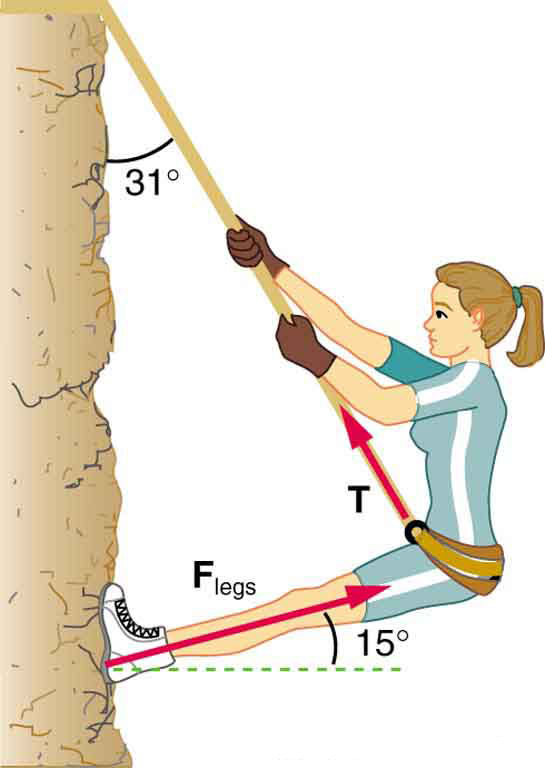
9: A contestant in a winter sporting event pushes a 45.0-kg block of ice across a frozen lake as shown in Figure 9(a). (a) Calculate the minimum force F he must exert to get the block moving. (b) What is the magnitude of its acceleration once it starts to move, if that force is maintained?
10: Repeat Exercise 18 with the contestant pulling the block of ice with a rope over his shoulder at the same angle above the horizontal as shown in Figure 9(b).
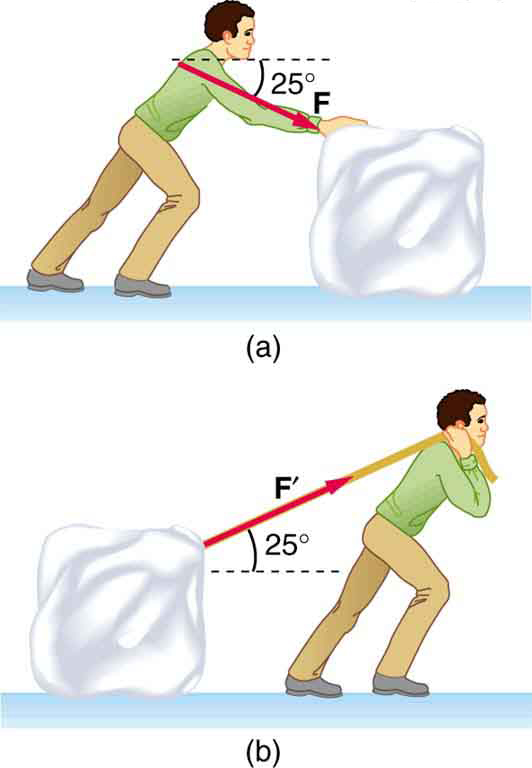
Glossary
- friction
- a force that opposes relative motion or attempts at motion between systems in contact
- kinetic friction
- a force that opposes the motion of two systems that are in contact and moving relative to one another
- static friction
- a force that opposes the motion of two systems that are in contact and are not moving relative to one another
- magnitude of static friction
- fs ≤ μsN, where μs is the coefficient of static friction and N is the magnitude of the normal force
- magnitude of kinetic friction
- fk = μkN, where μk is the coefficient of kinetic friction
Solutions
Problems & Exercises
2: (a) [latex]\boldsymbol{3.29\textbf{ m/s}^2}$ (b) $\boldsymbol{3.52\textbf{ m/s}^2}$ (c) $\boldsymbol{980\textbf{ N; }945\textbf{ N}}[/latex]
6: [latex]\boldsymbol{1.83\textbf{ m/s}^2}[/latex]
9: (a) [latex]\boldsymbol{51.0\textbf{ N}}[/latex] (b) [latex]\boldsymbol{0.720\textbf{ m/s}^2}[/latex]

